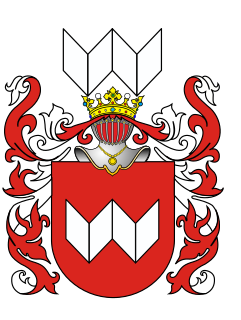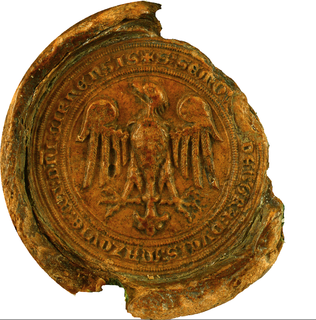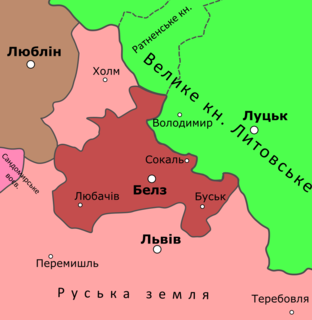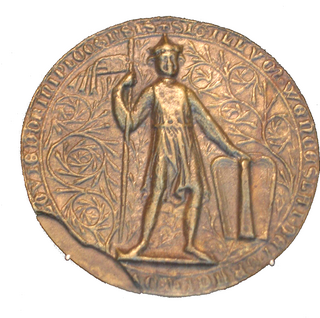Casimir II of Belz (pl: Kazimierz II bełski; 1401/03 – 15 September 1442), was a Polish prince member of the House of Piast from the Masovian branch. He was a Duke of Płock, Rawa Mazowiecka, Gostynin, Sochaczew, Belz, Płońsk, Zawkrze and Wizna during 1426–1434 jointly with his brothers, and after the division of the paternal inheritance between him and his brothers in 1434, sole ruler over Belz.

Płock is a city on the Vistula river in central Poland. It is located in the Masovian Voivodeship, having previously been the capital of the Płock Voivodeship (1975–1998). According to the data provided by GUS on 30 June 2009 there were 126,675 inhabitants in the city. Its full ceremonial name, according to the preamble to the City Statute, is Stołeczne Książęce Miasto Płock. It is used in ceremonial documents as well as for preserving an old tradition.

Rawa Mazowiecka is a town in central Poland, with 17,561 inhabitants (2016). It lies in the Łódź Voivodeship and is the capital of the Rawa County.

Gostynin(listen) is a town in Central Poland with 19,414 inhabitants (2004). It is situated in the Masovian Voivodship since 1999 and was previously in the Płock Voivodship from 1975 to 1998. It is the capital of Gostynin County.
He was the third son of Siemowit IV, Duke of Masovia and Alexandra of Lithuania, daughter of Algirdas.
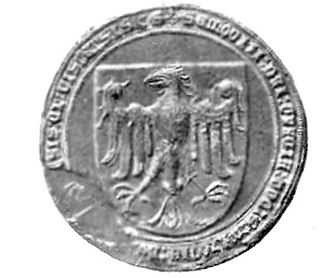
Siemowit IV, also known as Siemowit IV the Younger, was a Polish prince member of the House of Piast from the Masovian branch, from 1373/74 Duke of Rawa, and after the division of the paternal inheritance between him and his brother in 1381, ruler over Rawa, Płock, Sochaczew, Gostynin, Płońsk and Wizna, since 1386 hereditary Polish vassal, since 1388 ruler over Belz, during 1382–1401 he lost Wizna and during 1384–1399 and 1407–1411 he lost Zawkrze, during 1384–1399 he lost Płońsk, taken by the Teutonic Order.
Alexandra was the youngest daughter of Algirdas, Grand Duke of Lithuania, and his second wife, Uliana of Tver. Though Alexandra's exact date of birth is not known, it is thought that she was born in the late 1360s or early 1370s. In 1387, she married Siemowit IV, Duke of Masovia, and bore him thirteen children.

Algirdas was a ruler of medieval Lithuania. He ruled the Lithuanians and Ruthenians from 1345 to 1377. With the help of his brother Kęstutis he created an empire stretching from the present Baltic states to the Black Sea and to within fifty miles of Moscow.
Life
As a child, Casimir II was sent to Lithuania, an event that in the future would give him the support of the Grand Duke Vytautas. Also, he spend some time at the court of King Władysław II Jagiełło of Poland.

Lithuania, officially the Republic of Lithuania, is a country in the Baltic region of Europe. Since its independence, Lithuania is considered to be one of the Baltic states. It is situated along the southeastern shore of the Baltic Sea, to the east of Sweden and Denmark. It is bordered by Latvia to the north, Belarus to the east and south, Poland to the south, and Kaliningrad Oblast to the southwest. Lithuania has an estimated population of 2.8 million people as of 2019, and its capital and largest city is Vilnius. Other major cities are Kaunas and Klaipėda. Lithuanians are Baltic people. The official language, Lithuanian, along with Latvian, is one of only two living languages in the Baltic branch of the Indo-European language family.

Vytautas, also known as Vytautas the Great from the 15th century onwards, was a ruler of the Grand Duchy of Lithuania, which chiefly encompassed the Lithuanians and Ruthenians. He was also the Prince of Hrodna (1370–1382), Prince of Lutsk (1387–1389), and the postulated king of the Hussites.
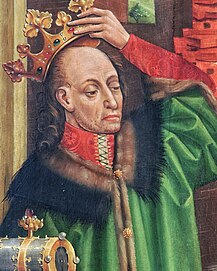
Jogaila, later Władysław II Jagiełło was the Grand Duke of Lithuania (1377–1434) and then the King of Poland (1386–1434), first alongside his wife Jadwiga until 1399, and then sole King of Poland. He ruled in Lithuania from 1377. Born a pagan, in 1386 he converted to Catholicism and was baptized as Władysław in Kraków, married the young Queen Jadwiga, and was crowned King of Poland as Władysław II Jagiełło. In 1387 he converted Lithuania to Christianity. His own reign in Poland started in 1399, upon the death of Queen Jadwiga, and lasted a further thirty-five years and laid the foundation for the centuries-long Polish–Lithuanian union. He was a member of the Jagiellonian dynasty in Poland that bears his name and was previously also known as the Gediminid dynasty in the Grand Duchy of Lithuania. The dynasty ruled both states until 1572, and became one of the most influential dynasties in late medieval and early modern Central and Eastern Europe. During his reign, the Polish-Lithuanian state was the largest state in the Christian world.
After 1420 Siemowit IV, due to his progressive blindness, gradually gave participation in the government to his adult sons. Casimir II and his older brother Siemowit V were formally named co-rulers. The first major challenge for Casimir II was the trip to Brest-Litovsk, where on 14 November 1425 he and his brother solemnly vowed to the crown his fidelity and acceptance in the recent controversy over the appointment of Stanisław z Pawłowic (former Chancellor of Siemowit IV) as Bishop of Płock.
Siemowit V of Rawa, was a Polish prince member of the House of Piast from the Masovian branch. He was a Duke of Rawa Mazowiecka, Płock, Sochaczew, Gostynin, Płońsk, Wizna and Belz during 1426-1434 jointly with his brothers, and after the division of the paternal inheritance between him and his brothers in 1434, sole ruler over Rawa Mazowiecka, Gostynin and Sochaczew.

Brest, formerly Brest-Litowsk, is a city in Belarus at the border with Poland opposite the Polish city of Terespol, where the Bug and Mukhavets rivers meet. It is the capital city of the Brest Region.
Siemowit IV died on 21 January 1426 leaving his domains to his four sons: Siemowit V, Casimir II, Trojden II (d. 1427) and Władysław I (a fifth son, Alexander, followed a Church career). Not wanting to further weakened their positions and domains with subsequents divisions, they decided to co-rule all their paternal inheritance.
Trojden II of Płock, was a Polish prince member of the House of Piast from the Masovian branch. He was a Duke of Płock, Rawa Mazowiecka, Gostynin, Sochaczew and Belz during 1426-1427 jointly with his brothers.

Władysław I of Płock, was a Polish prince member of the House of Piast from the Masovian branch. He was a Duke of Płock, Rawa Mazowiecka, Gostynin, Sochaczew, Belz, Płońsk, Zawkrze and Wizna during 1426-1434 jointly with his brothers, after the division of the paternal inheritance between him and his brothers in 1434, sole ruler over Płock, Płońsk, Wizna and Zawkrze; in 1442 he reunited all their patrimony.

Alexander of Masovia was a Polish prince member of the House of Piast from the Masovian branch. He was Bishop of Trento since 1425, titular Patriarch of Aquileia since 1439, Cardinal nominated by Antipope Felix V as titular of the diocese of St. Lawrence at Damascus since 1440, titular Bishop of Chur since 1442 and rector at St. Stephen's Cathedral, Vienna since 1442, a diplomat.
In accordance with their duties as Polish vassals, soon after they assumed the power went to Sandomierz, where on 8 September 1426 paid homage to King Władysław II. Surprisingly, Casimir II was absent in the ceremony, and also began to refuse the payment of the customary tribute in successive periods (among his notorious absences was in 1428 at Łęczyca). The Polish King began to fear that the refusal of one of the Masovian co-rulers to paid homage could give the others reasons to invalidate their feudal dependence. This situation could be maintained largely thanks to the support granted to Casimir II by the Lithuanian ruler Vytautas, who took up the prince on a campaign organized in 1428 against Veliky Novgorod. The unexpected illness and death of his protector Vytautas forced Casimir II to change his position: in September 1430 at Sandomierz and almost four years after his brothers, he finally paid homage to the Polish King.

Sandomierz is a town in south-eastern Poland with 25,714 inhabitants (2006), situated in the Świętokrzyskie Voivodeship. It is the capital of Sandomierz County. Sandomierz is known for its Old Town, which is a major tourist attraction. In the past, Sandomierz used to be one of the most important urban centers not only of Lesser Poland, but also of the whole country.
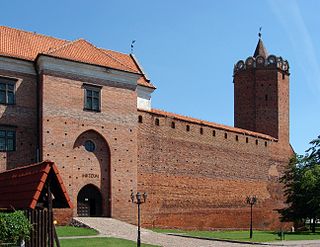
Łęczyca is a town of 14,362 inhabitants in central Poland. Situated in the Łódź Voivodeship, it is the county seat of the Łęczyca County.

Veliky Novgorod, also known as Novgorod the Great, or Novgorod Veliky, or just Novgorod, is one of the oldest and most important historic cities in Russia, which serves as the administrative center of Novgorod Oblast. It is situated on the M10 federal highway connecting Moscow and Saint Petersburg. The city lies along the Volkhov River just downstream from its outflow from Lake Ilmen. UNESCO recognized Novgorod as a World Heritage Site in 1992. Population: 218,717 (2010 Census); 216,856 (2002 Census); 229,126 (1989 Census).
In 1431 Casimir II, fulfilling his obligations as Polish vassal, arrived at the head of his troops to join King Władysław II in his fight against Švitrigaila. The Masovian prince didn't take part of the whole campaign, focusing on suppressed the riots of the Ruthenians, instigated by Švitrigaila's agents.
King Władysław II died on 1 June 1434, and this allowed to the Masovian rulers more freedom and flexibility in their government. In July 1434 Casimir II and Siemowit V arrived in Kraków, where they attended the coronation of the new Polish King, Władysław III.
On 31 August 1434 the sons of Siemowit IV finally decided to end their co-rulership and made the formal territorial division. On 31 December 1435, Casimir II (now Duke of Belz) signed the Peace of Brześć Kujawski. [1] In the following years, Casimir II was focused in the government of his domains, who were in the Polish-Lithuanian border; this obviously originated conflicts between the Polish (mainly from Lesser Poland) nobility and Švitrigaila's magnates. The fights with varying degrees of success continued until 4 September 1437, where, in presence of Casimir II, the Polish nobles concluded at Lviv the final peace with Švitrigaila.
Three years later (1440), Casimir II also supported the expedition of Prince Casimir of Poland to Vilnius in order to obtain the title of Grand Duke of Lithuania.
In his internal politics, Casimir II made a gradual assimilation of the Red Ruthenia parts ruled by him and his brothers, into the Polish customs and laws. This involved, among others, the introduction of the Polish laws and administration.
On 26 June 1442 Casimir II married Margaret (d. 5 November 1464), a daughter of Castellan Vincent Szamotuły from Międzyrzecz. Unfortunately, the union was short-lived and childless: three months later, on 15 September 1442 Casimir II died in the village of Miączyn near Krasnystaw, victim of the plague. He was buried in the Masovian Ducal crypt at Płock Cathedral. His domains were inherited by his brother Władysław I.

















